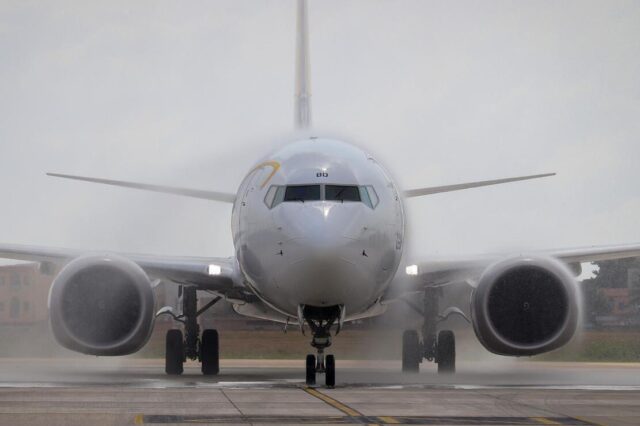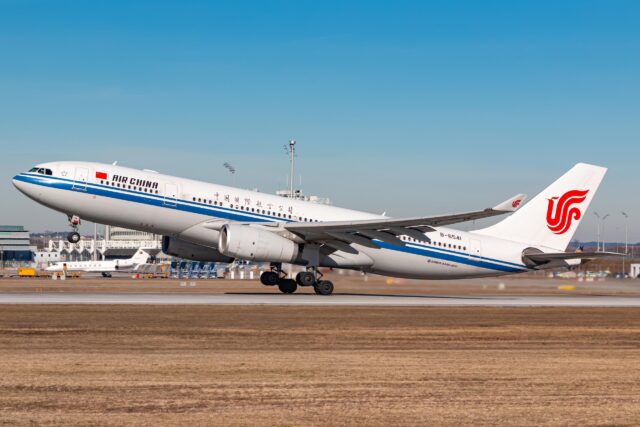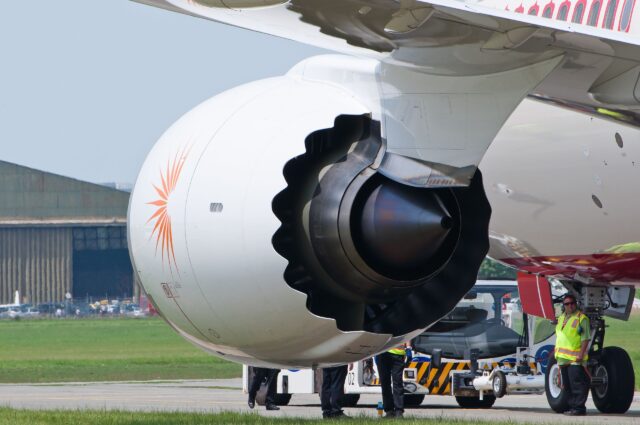B-52 bombers circle Venezuela as the US ramps up its Caribbean military presence

October 16, 2025

In a demonstration of America’s long-range strike capabilities, three US Air Force (USAF)-operated B-52H Stratofortress strategic bombers were observed as they traced orbits in international airspace near Los Roques, Venezuela, on October 15. This mission was a major show of force against Venezuelan dictator Nicolás Maduro, with their presence punctuating Washington’s broader military build-up in the Caribbean.

The US military’s growing multi-domain presence in the region aims to target and deter the northern flow of illegal narcotics into the Continental US (CONUS) under the direction of the Trump administration, which has been applying pressure on the Maduro regime in Venezuela, in particular, and has not ruled out the possibility of taking direct military action against Caracas.
B-52s demonstrate long-range strike capability near Venezuela
In this recent show of force, which was trackable on public flight-tracking websites, the three B-52Hs of ‘BUNNY’ flight – comprising 60-0010, callsign ‘BUNNY01’; 60-0052, callsign ‘BUNNY02’; and 60-0033, callsign ‘BUNNY03’ – departed Barksdale Air Force Base (AFB) in Louisiana early in the morning of October 15. The bombers initially flew south before turning east and loitering in international airspace within the Venezuelan-controlled Maiquetía Flight Information Region (FIR) for roughly two hours before departing the area.
BUNNY01 flt now orbiting within the confines of the MAIQUETIA FIR. The FIR doesn’t not constitute Venezuelan airspace but simply a ATC sector that they control. Are the B-52s talking to MAIQUETIA CONTROL or DUE REGARD? I don’t know. @liveatc had a MAIQUETIA ATC feed up 2 days ago… https://t.co/rM4PHgvBb5 pic.twitter.com/Evw1nJOxRx
— Thenewarea51 (@thenewarea51) October 15, 2025
Such flights within the Maiquetía FIR have not been uncommon since the US military began expanding its presence in the Caribbean. In recent weeks, US military aircraft – including USAF air-to-air refuelling (AAR) assets and presumably US Marine Corps (USMC)-operated F-35B Lightning IIs – have been tracked as they flew missions within this region.
While the B-52Hs were orbiting near Los Roques, it was reported that an unspecified number of F-16A/B Fighting Falcons from the Venezuelan Air Force’s Grupo Aéreo de Caza 16 (GAC 16; Fighter Air Group 16) had taken off from El Libertador Air Base, which is located to the west of Caracas. However, it remains unclear if an attempt to intercept the bombers was made or whether these jets had departed to conduct an unrelated training mission as part of new drills that Maduro ordered that same day.
Venezuelan F-16s are reported as just departing from BAEL (El Libertador Airbase) as the B-52s turn north and head out of the Maiquetia FIR https://t.co/sRcEVWDvzu
— CNW (@ConflictsW) October 15, 2025
The close and open presence of these B-52Hs near Venezuelan territory was intended to send a clear message to Maduro and his regime as tensions continue to grow between Washington and Caracas, with such missions further escalating the possibility of direct military conflict between the two nations.
While B-52Hs have participated in counter-narcotics operations – albeit in a limited capacity – for decades, this show of force likely demonstrated the threat that the bomber poses when it comes to launching stand-off attacks outside of Venezuela’s air-defence network in a move that would be exploited if conflict were to break out between the two countries.
US Navy reinforces presence with carrier and amphibious forces
Washington has been steadily growing its forward presence in the Southern Caribbean since late August, when a naval build-up in the region began after President Trump ordered the US military to start using force against drug trafficking operations coming from Latin America.
On September 2, the first operation of this campaign was conducted when a vessel sailing from Venezuela was struck and sunk, killing 11 people. The vessel was allegedly carrying members of the Venezuelan-based Tren de Aragua gang, which was declared a terrorist organisation by the US government in January.
After a brief delay caused by Hurricane Erin, the US Navy’s Wasp-class amphibious assault ship, USS Iwo Jima (LHD-7), emerged as a key instrument in Washington’s counter-narcotics operations in the Caribbean. By early September, satellite imagery placed the Iwo Jima Amphibious Ready Group (ARG) – which also comprises the San Antonio-class amphibious transport dock ships, USS Fort Lauderdale (LPD-28) and USS San Antonio (LPD-17) – approximately 340 miles (548km) off the Venezuelan coast.

Embarked aboard Iwo Jima for the duration of this deployment are personnel and aircraft assigned to the 22nd Marine Expeditionary Unit (MEU) Special Operations Capable (SOC). Aircraft operations from Iwo Jima are carried out under the command of the USMC’s Marine Medium Tiltrotor Squadron 263 (Reinforced) ‘Thunder Chickens’ – also known as VMM-263(REIN) – which operates the MV-22B Osprey tiltrotor but is also temporarily equipped with AH-1Z Viper gunships, UH-1Y Venom utility helicopters and CH-53E Super Stallion heavy-lift transport helicopters.
Fixed-wing combat operations from Iwo Jima are carried out by a detachment of vertical take-off and landing (VTOL)-capable AV-8B Harrier IIs from Marine Attack Squadron 223 (VMA-223) ‘Bulldogs’, which are home-based at MCAS Cherry Point, North Carolina. These aircraft are temporarily assigned to VMM-263(REIN) for the duration of this deployment.

Through September, personnel attached to the ARG launched a series of amphibious, aerial and coordination exercises around Puerto Rico to train against realistic threats, while also working to interdict drug smuggling routes. On September 8, US Secretary of Defense Pete Hegseth paid a surprise visit to Iwo Jima while it was operating off Puerto Rico and reaffirmed that this was “no training” mission, but a real-world operation to stem the flow of narcotics into the US.
Notably, Iwo Jima’s ongoing Caribbean cruise marks the first time a US-based ARG has embarked on an operational deployment since December 2024, ending an eight-month gap in the US Navy and USMC’s global ARG and MEU presence. This cruise comes as the Navy continues to struggle to improve the readiness of its amphibious warship fleet, with ongoing maintenance issues delaying deployments and leading to disaggregated formations operating at sea.

The US Navy has also deployed four Arleigh Burke-class guided-missile destroyers – comprising USS Sampson (DDG-102), USS Stockdale (DDG-106), USS Gravely (DDG-107) and USS Jason Dunham (DDG-109) – to the Caribbean, as well as the Ticonderoga-class guided-missile cruiser, USS Lake Erie (CG-70), and the Freedom-class littoral combat ship, USS Minneapolis-St Paul (LCS-21).
Also present in the region is the Los Angeles-class fast attack submarine, USS Newport News (SSN-70), and the special warfare support vessel, MV Ocean Trader, which resembles a commercial vessel but is used to support covert operations.
In addition to these naval assets, the US Navy is also flying persistent surveillance missions with deployed P-8A Poseidon maritime patrol aircraft (MPA) that have been deployed to the region in support of the counter-narcotics effort.
USMC F-35Bs deploy to Puerto Rico for counter-narcotics patrols
On September 13, ten short take-off and vertical landing (STOVL)-capable F-35Bs from the USMC’s Marine Fighter Attack Squadron 225 (VMFA-225) ‘Vikings’ deployed from their home base at MCAS Yuma, Arizona, to the former Roosevelt Roads Naval Station in Puerto Rico to support the ongoing counter-narcotics operation. Notably, all of the deployed fifth-generation fighters arrived in Puerto Rico without unit markings, but captions of images showing their arrival stated that the aircraft belonged to the Yuma-based ‘Vikings’.

These F-35Bs have been active since they arrived in the region, with claims that the fighters have been flying patrol missions within the Maiquetía FIR. On October 2, Venezuela’s Defence Minister Vladimir Padrino López claimed that five F-35s had been detected operating within the Maiquetía FIR by the country’s integrated air defence system. Furthermore, USAF AAR assets have been visible over the Southern Caribbean on public flight-tracking websites over recent weeks and were likely supporting operations by these F-35s and other US military air assets.
USAF Ghostriders and Reapers expand aerial overwatch
In addition to the detachment of USMC F-35Bs at Roosevelt Roads, USAF-operated MQ-9A Reaper unmanned combat air vehicles (UCAVs) and AC-130J Ghostrider fixed-wing gunships have now been spotted flying missions from Puerto Rico. Both of these types are commonly tasked with performing interdiction and armed overwatch missions, as well as close air support (CAS) engagements in support of special forces operations.
El que faltaba se unió al grupo.
— 𝘼𝙧𝙧𝙚𝙘𝙝𝙤 (@Arr3ch0) October 10, 2025
El temido Fuerza Aérea 🇺🇲 AC-130J Ghostrider registro 16-5837 activo en Jose Aponte de la Torre (TJRV), Puerto Rico.
Miren los cañones 30mm GAU-23 automatico y 105mm M102 howitzer además de los misiles Hellfire x 8
📸 de Omar Y. Perez ayer 9/Oct pic.twitter.com/ztrQGiIU2E
At least two AC-130Js (including 15-5825 and 16-5837) from the USAF’s 1st Special Operations Wing (SOW) at Hurlburt Field in Florida are known to have been deployed to José Aponte de la Torre Airport and have been noted as flying sorties from Puerto Rico throughout early October. The aircraft – which are each armed with a 30mm GAU-23/A autocannon and 105mm M102 howitzer – have also been spotted carrying eight wing-mounted AGM-114 Hellfire air-to-ground missiles.
Meanwhile, at least five MQ-9As (including 15-4275, 17-4356, 19-4390, 19-4398 and 20-4408) have also been spotted flying sorties from Rafael Hernández Airport in Aguadilla, Puerto Rico, in support of America’s growing counter-narcotics effort in early October. While these unmanned assets are capable of conducting air-to-ground combat over land or at sea, they could also be used to gather important intelligence on narcotics routes in support of the wider mission.
A new publicly available image shows a sixth USAF MQ-9A that has flown/is flying out of Aguadilla (BQN/TJBQ) 🇵🇷 in support of ongoing counternarcotics ops in the Caribbean.
— LatAmMilMovements (@LatAmMilMVMTs) October 6, 2025
The complete serials should be: 14-4242, 14-4275, 17-4356, 19-4390, 19-4398, 20-4408. https://t.co/7zI3abUXrY pic.twitter.com/X1PqxghSFZ
A growing US presence in the Caribbean
Washington has now reportedly forward-deployed some 10,000 personnel to the Caribbean region in support of this ongoing effort. Of these, some 4,500 personnel alone are assigned to the Iwo Jima ARG.
Since September, the US has carried out at least five lethal strikes on small boats operating in the Caribbean, all of which were allegedly involved in drug trafficking operations.
While the total number of fatalities has not been formally confirmed, the US military is thought to have killed 27 individuals in these strikes.
Update – 20/10/2025
On October 17, the USAF’s Southern Command (AFSOUTH) released a series of images of the ‘bomber attack demonstration’ that was conducted off the coast of Venezuela by three B-52Hs on October 15. These images also confirmed that at least two of these bombers were escorted by a pair of armed F-35Bs from the USMC’s VMFA-225, which are currently forward-deployed to Puerto Rico.

In a Facebook post, AFSOUTH said that the October 15 mission demonstrated Washington’s commitment “to proactively deter adversary threats to the US homeland and the region, enhance crew training, and ensure the global force readiness necessary to respond to any contingency or challenge.”
Notably, these fifth-generation fighters were armed with AIM-9X Sidewinder short-range air-to-air missiles, which were carried on external underwing pylons for the duration of the sortie. While this setup will have increased the F-35B’s radar signature – albeit slightly – this configuration reflects the relatively low-threat environment of the Caribbean, while enhancing its airborne self-defence options.
















